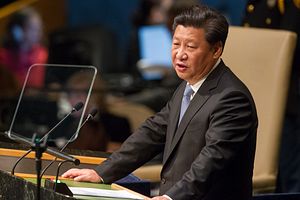After a long delay, China’s military, the People’s Liberation Army, is finally beginning to reform itself in a big way (see here, here, and here for details). These reform measures are the most significant changes to the PLA since the 1950s and will have huge implications for China’s future international behavior and global order.
The details of the sweeping reforms are hard to list here, but the major ones include strengthening the role of the Central Military Commission, restructuring the existing seven military regions, cutting off some non-military organizations, and increasing the power of the Military Party Discipline Commission. Combined with President Xi Jinping’s promise in September to cut 300,000 troops, these reforms are indeed unprecedented.
The obvious question here is why China is reforming its military in such a drastic way. Although there are many possible explanations, one explanation is particularly simple and powerful: China’s existing military organization is not effective enough to defend its national interests in a rapidly changing world.
Some analysts in China call such reforms a shift to a U.S.-style military from an outdated Soviet model. In a narrow sense, this is exactly China’s goal. The U.S. military, despite its problems, is far more advanced and effective than any other military in the world in terms of its ability to fight and win a modern war. Although, as I have argued elsewhere, China’s PLA can also fight a modern war, its expectation of winning against the U.S. military are not great. One of main reasons is China’s slow and ineffective regional structures. China badly needs a joint operational command in order to win a modern war. These reforms address these shortcomings.
The deeper reason for China’s sweeping military reforms include its increasingly deteriorating security environment. This might sound odd because China is currently the second largest economy in the world and its military is also one of the biggest in the world. If anything, China now possesses more material prowess to fight and win a modern war. Although true to some degree, there is a dark side for the PLA’s capabilities.
First, China is involved in multiple territorial disputes with other Asian countries. This means that it is at least theoretically possible that China’s military might one day face two enemies simultaneously, possibly in the East China Sea and the South China Sea. But China’s Navy is not yet mature enough to fight two wars simultaneously.
Second, there is also the problem of information gathering capabilities and experience. The PLA has not fought a war for nearly 30 years whereas the United States has been mired in war for the most part since the end of the Cold War. There is still a big question mark over the PLA’s true war-fighting capabilities. This is more pertinent given the recent tragedy of a Chinese national being killed by ISIS. There is a growing voice within China that is calling for the government to take part in or even send troops to Iraq and Syria to fight ISIS, but a popular and convincing objection is that the PLA simply has no fighting experience. Thus, sending them over to the Middle East would only end in disaster.
Third, there is still the lingering problem of corruption. It is a consensus among China’s military experts that corruption is the number one killer of the PLA on the battlefield. Before these reforms were announced, the PLA’s Discipline Commission was relatively weak, unable to bring in its own members for justice. Now the Commission directly reports to Xi, which should, in theory, greatly enhance the Party’s ability to fight corruption nationwide.
In short, these reforms are supposed to address the existing flaws of the PLA and help it emerge as a potent war-fighting force. Once the reforms are completed, we should expect to see a leaner and more lethal PLA, which might or might not be good news for others in Asia. One thing is clear though: every other power must pay serious attention to the PLA’s fighting capabilities.

































